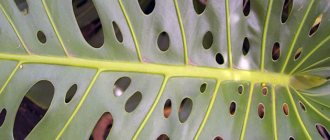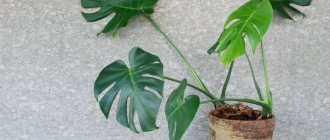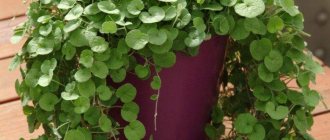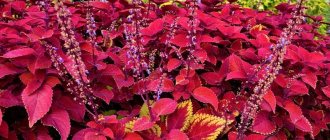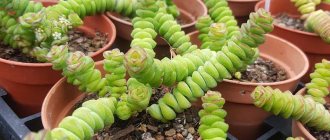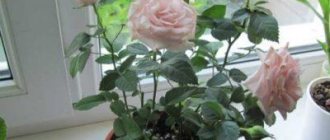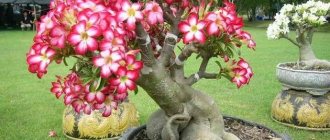Monstera is an evergreen exotic liana of the Araceae family. The epiphyte is native to the humid tropics of South America. The plant has large leaves with cuts or whole. At the top of the shoot there is a growth point.
The adventitious roots are quite long, thick and brittle. The flowers are inconspicuous, but the fruits are edible. The plant genus includes about 50 species and many varieties.
Types of monstera for the home - table
Not all types of plants are suitable for home cultivation; it depends on the region. Most often, two types are grown: oblique and lovely. You can try to keep the vines presented in the table at home:
| Kinds | Description |
| Lovely (Delicacy, Alba, Deliciosa) | Oval leathery carved leaves. The stems are thick and fleshy. |
| Variegata | Variegated leaves with light streaks. Yellow and green colors predominate. |
| Oblique | Slightly dissected oval leaves with short petioles. |
| Adanson (Irregular) | Heavily dissected ovoid thin leaf blades with small holes. |
| Thin | Rarely seen. Pinnately dissected openwork leaves. Slow growth. |
| Borziga | An unpretentious small vine. A variety of Monstera Deliciosa. |
| Doubtful (Dubia) | A small vine with entire leaves. |
Delicatessen
Oblique
Adanson
Thin
Borziga
Dubia
Variegata
Unpretentious nature allowed plants to decorate rooms of houses, offices, and botanical gardens. Thus, the variegated monstera is a symbol of luxury and wealth. It should be remembered that many vines reach large sizes and require a specific place: some species grow up to 3 meters in height.
Monstera variegated in the interior
Plant setcreasia purpurea or phylloetaceae, variegated
All types of monstera look harmonious in the interior of an apartment, and the variegated monstera will become a real decoration for any room, be it a kitchen or a living room. With its help you can create the feeling of being in a tropical forest. Monstera looks impressive in the interior of any apartment.
Note! If you want to refresh the design and decorate the room, then you can combine monstera leaves in the interior with dim objects in the house, gray walls, and soft colors. They will fit into the design of the living room and bedroom due to their variegated leaves.
Monstera in design
Caring for monstera by season - table
Liana does not require complex care. She needs a lot of water in the warm season, rest in winter and timely pruning.
At low temperatures in the house, watering should be sparse. Feeding is carried out approximately once every 30 days during growth. If the plant is always in the shade, its crown will become smaller. At very low temperatures, the leaves can turn black, and if you add abundant watering to this, they become lethargic. When the temperature is too high, the leaves curl, this occurs more often in winter.
The table shows plant care by season:
| Season | Lighting | Humidity | Temperature conditions |
| Spring Summer | Slight shadow or diffuse light. To avoid burns, it requires shading on the sunny side. In poor lighting, the leaves become smaller and cuts do not form. | Moderate. In hot weather, spraying is recommended. | From +20 to +25°C without sudden changes. No drafts. |
| Autumn winter | Artificial lighting is required. | Moderate. Regular spraying in a warm room. | Not lower than +12°C. Away from heating devices. |
It is difficult, and sometimes impossible, to achieve monstera flowering at home, since it prefers to bloom in natural conditions, but if you follow all the simple rules for caring for it, this can be achieved.
What is Monstera variegata?
Monstera variegata is the species most suitable for keeping in an apartment, because these plants, with proper maintenance, fit even in a small room. It has variegated white-green leaves, and the area of white color increases with age. Some specimens brought from Holland become ordinary over time, that is, they lose their white color.
What does a flower look like
All species are considered large plants, but if desired, you can provide the proper conditions for this monster in a small room, but this cannot be done without basic knowledge about care.
For your information! The flower was bred artificially, because of this it is more capricious, but with proper care, the variegated monstera will delight you for many years.
Planting, replanting, pruning, support
When planting a plant, you need to pay attention to the soil. It should be loose and neutral. There are several mixture options:
- take one part each of humus, peat and sand and add 2 parts of turf;
- mix one part each of bark, leaf soil, peat, moss and ½ part coarse sand;
- Add coconut fiber or perlite to the purchased soil for Saintpaulia.
Young vines should be replanted annually, as they grow very quickly. The pot should be 2-3 cm larger than the old one. It is better if its height and diameter are approximately equal. In a cramped container, the leaves may turn brown and thin, like papyrus.
The soil, drainage material and container must first be sterilized. Drainage should occupy approximately a fifth of the volume.
The plant must be replanted carefully, along with a lump of earth. Dry damaged roots must be trimmed. The vine is placed in the middle of the new container, covered with earth and lightly compacted.
Adult vines are replanted after two years. You will need fairly large flowerpots. It will depend on them how large the vine will be. The new container should be larger than the old one so that the root system feels comfortable.
Since the plant is quite large, it is better to transplant it together. Make the transplant step by step.
Replanting a very large monstera is a difficult task, so over time, only the top old layer of soil is changed with the addition of humus. If you don’t want such problems, you can start a mini plant.
A young monstera definitely needs support, as it curls. In addition, the vine will look more attractive. It is placed in a permanent place and sprayed. For an adult plant, you can make the support yourself. Sticks with coconut fiber are not a very suitable option, as it is difficult for the vine to gain a foothold. To make a support, you can take a piece of plastic tube, longer than the plant, and drill many slots in it. Next, place it in a pot and pour sand inside to the surface of the soil. Moss mixed with peat should be poured on top. The support is wrapped with damp moss, a mesh with cells on top and secured with fishing line. This design also requires regular spraying. Other options are possible.
The plant grows aerial roots, but they cannot be removed. If a vine climbs up a moss tube, the roots will grow into it themselves.
When an adult plant stops growing intensively, you can cut off its top for rejuvenation. The cut should be sprinkled with coal. This procedure promotes the growth of side shoots and crown formation.
How to form a monstera at home
Monstera flower - what the plant and leaf look like
Any owner of this “monstrous” flower sooner or later wonders how to prune Monstera variegata. This procedure is needed when the plant has grown greatly or vice versa, in order to accelerate its growth or provoke lush branching.
Important! Diseased or dead leaves should be trimmed.
The formation process is extremely simple: excess branches are cut off with clean scissors. To activate the growth of shoots, you should pinch off a small part and sprinkle the cut with ash.
For your information! Monstera is a poisonous plant, so you need to use gloves or, at a minimum, wash your hands thoroughly after the procedure.
Watering, fertilizer
Caring for vines at home is not difficult. The plant does not require frequent watering, although it is moisture-loving. Monstera leaves are covered with a waxy coating and evaporate little moisture. Watering is carried out after the soil has dried from above, preferably with warm water.
Young plants do not need fertilizing, but adults need organic and mineral fertilizers 2 times a month during the warm seasons of the year.
Flower shops have a wide selection of fertilizers. For example, “Agricola 7”, “Nitrophoska”, “Lingogumat” and others. Before use, you should read the instructions.
evergreen liana
Raphidophora is a climbing plant of the Araceae family of rich dark green color. In nature, it grows in tropical rainforests and subtropics: the Himalayas, Nepal, East and West Malaysia, the Philippines, tropical Africa. The genus Raphidophora includes hundreds of species - from miniature to huge, but most of them are not suitable for indoor breeding. There are a couple of species that are easy to create comfortable conditions within the walls of the house, and we’ll tell you about them.
Reproduction
Monstera propagates by seeds, cuttings and air layering:
- When propagating by seeds, light and warmth are needed. Seeds are placed in soil or damp moss. They should emerge in a month. It is recommended to leave the planting material overnight in a growth stimulator.
- When propagated by cuttings, stem or lateral shoots are planted in a pot under glass. Cuttings should be short with 1-2 leaves. A cut is made at a right angle on top, and an oblique cut on the bottom. Plantings should be watered and sprayed as the top layer of soil dries. The plant takes root and is placed in a pot.
- A layer with an aerial root and a leaf is planted in a pot.
Myths
Colonizers of the 18th century, making their way through tropical forests, were frightened by the terrifying appearance of the vine. Dissected leaves with drops of moisture appearing before the rain, as well as gnarled stems and long aerial roots did not cause delight.
It is worth mentioning how the monstera blooms: the white inflorescence from a distance resembles a hood. After flowering, an elongated fruit appears.
Modern skeptics focus on the dissonant name and the idea that the plant absorbs a lot of oxygen at night. It is believed that the rate of consumption in the dark for Monstera is the same as for an adult. Hence the myth that you can suffocate in your sleep if a flower pot is in the bedroom .
Attention! The leaves of the vine do not pose any danger to either a sleeping or a waking person. It breathes around the clock, but in daylight photosynthesis occurs, that is, the plant releases more oxygen than it absorbs.
The poisonous nature of the vine is another misconception. There are rumors that you can be poisoned by any part of the plant. In fact, only the needle-like formations located in the leaves are dangerous.
When they get on the mucous membrane of the mouth, they cause irritation. The remaining parts are safe. In Asian countries, monstera fruits are added to various dishes.
Pests, diseases, possible problems - table
Diseases and pests rarely affect the vine, but sometimes they cause its death. The plant's leaves may curl, fall off, turn yellow, and dry out.
| Plant diseases | External signs | Fighting methods |
| Chlorosis (carried by aphids and mites) | Yellowing of leaves, appearance of light spots. | Processing with phytofarm. Feeding. Maintaining cleanliness. |
| Root rot | Yellowing and wilting of leaves. | Regulating the watering regime. Removing rotten roots and sprinkling the cuts with charcoal. |
| Spider mite | The appearance of yellow spots and spots on the leaf blades. Falling leaves. Presence of white cobwebs. | Treatment with phytoferm or derris. Regular shower with warm water. |
| Aphid | Curling, deformation and drying of young leaves. | Treatment with insecticide against aphids and preparations with permethrin. |
| Shchitovka | The appearance of hard brown plaques on the back of the leaves, drying of the tips. | Repeated treatment with a damp cloth with soapy water and insecticide. |


